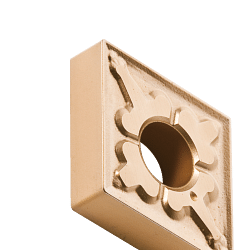< Turning tools Inserts for grooving and shearing
In the world of machine shops, efficiency and precision are key elements in guaranteeing the quality of the end product. Among the tools that play a crucial role in this context, grooving and parting-off inserts stand out for their ability to optimise machining processes. Although they may seem simple, these components are the result of advanced technological innovation and meticulous design, making them indispensable for many industrial applications.
Understanding grooving and parting inserts
Grooving and parting-off inserts are cutting tools used primarily in turning operations. Their main function is to create grooves or to part pieces of material precisely and cleanly. These inserts are designed to withstand high mechanical and thermal stresses, ensuring long life and consistent performance.
The choice of material from which they are made is crucial. Inserts can be made of tungsten carbide, ceramic or other advanced materials, each of which offers specific advantages in terms of wear resistance and cutting capacity. The geometry of the insert is equally important, as it directly influences the quality of the cut and the efficiency of the process.
Applications and advantages of grooving and parting inserts
The applications for grooving and parting inserts are manifold and range from the automotive and aerospace industries to the production of electronic and mechanical components. In each sector, the aim is to achieve precise cuts and minimise machining waste.
One of the main advantages of using these inserts is their ability to improve productivity. Thanks to their precision, machining time can be reduced and production speed increased without compromising the quality of the final product. In addition, their resistance to wear reduces maintenance and replacement costs, offering considerable cost savings in the long term.
Optimising machining processes
To exploit the full potential of grooving and parting-off inserts, it is essential to take a strategic approach to their selection and use. The choice of the right insert depends on various factors, including the type of material to be machined, the specifications of the machinery used and the operating conditions.
An accurate analysis of production requirements and the characteristics of the material to be processed is the first step to ensure effective optimisation. Furthermore, the adoption of advanced technologies, such as tool performance monitoring systems, can help further improve the efficiency of the production process.
Answers to frequently asked questions about grooving and parting-off inserts
1. What are the most common materials used for inserts?
Grooving and parting-off inserts are commonly made of tungsten carbide, ceramic and cermet. Each material offers specific advantages in terms of wear resistance and cutting capability.
2. How do I choose the right insert for a specific application?
Choosing the right insert depends on various factors, including the type of material to be machined, machine specifications and operating conditions. It is advisable to consult an expert or specialist supplier for customised advice.
3. What are the main advantages of tungsten carbide inserts?
Tungsten carbide inserts offer high wear resistance and long tool life, making them ideal for applications requiring precision and reliability.
4. Can the grooving and parting inserts be used on different materials?
Yes, the inserts can be used on a wide range of materials, including ferrous and non-ferrous metals, plastics and composite materials. However, it is important to choose the right insert for the specific material to ensure optimal results.
5. How to keep inserts in optimal condition?
To keep inserts in optimal condition, it is essential to follow the manufacturer's recommendations in terms of cutting speed, feed rate and depth of cut. In addition, regular maintenance and visual inspection can help prolong the life of the inserts.
Conclusions
Grooving and parting inserts are a key element in the efficiency and precision of machining operations. Their ability to ensure precise cuts and reduce machining time makes them indispensable in many industries. Investing in the optimal choice and use of these tools can lead to significant improvements in productivity and end-product quality. With proper knowledge and strategic management, machine shops can take full advantage of these essential components.
Read More Read Less 

















